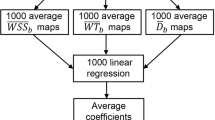Abstract
This paper presents a method for measuring arterial geometryin vivo using MRI. The approach was validated using MR images of three perfused compliant casts of human aortic bifurcations whose geometry was known. Preliminary human studies demonstrated the reproducibility of the technique. The approach was applied to 20 normal individuals to study the effects of age, race, and gender on the geometry of the aortic bifurcation. The results show that older people tend to have a smaller bifurcation angle, lower planarity, and larger angular asymmetry than younger people. Asians have larger bifurcation angles than whites. The bifurcation of males is more asymmetric than that of females. These results may have implications regarding the heritability of arterial geometry, the similarities of cardiovascular risk within families, and differences in risk among groups.
Similar content being viewed by others
References
Appel, A. Some techniques for shading machine renderings of solids. AFIPS 1968 Spring Joint Comput. Conf. 37–45; 1968.
Bargeron, C.B.; Hutchins, G.M.; Moore, G.W.; Deters, O.J.; Mark, F.F.; Friedman, M.H. Distribution of the geometric parameters of human aortic bifurcations. Arteriosclerosis 6:109–113; 1986.
Chakeres, D.W.; Schmalbrock, P. Fundamentals of magnetic resonance imaging. Baltimore: Williams & Wilkins; 1992.
Christiansen, H.N.; Sederberg, T.W. Conversion of complex contour line definitions into polygonal element mosaics. Comput. Graph. 12:187–192; 1978.
Edelman, R.R.; Mattle, H.P.; Atkinson, D.J.; Hoogewoud, H.M. MR angiography. Am. J. Radiology 154:937–946; 1990.
Fanucci, E.; Orlacchio, A.; Pocek, M. The vascular geometry of human arterial bifurcation. Investigative Radiology 23:713–718; 1988.
Fessler, J.A.; Macovski, A. Object-based 3-D reconstruction of arterial trees from magnetic resonance angiograms. IEEE Trans. Med. Imaging 10:25–39; 1991.
Friedman, M.H.; Deters, O.J.; Mark, F.F.; Bargeron, C.B.; Hutchins, G.M. Arterial geometry affects hemodynamics. A potential risk factor for atherosclerosis. Atherosclerosis 46:225–231; 1983.
Friedman, M.H.; Hacker, V.A.; James, B.F.; Kuban, B.D.; Qin, J.; Schmalbrock, P. MRI measurement of arterial branch geometry. In: Spilker, R.L.; Friedman, M.H., eds. 1991 Biomechanics Symposium. ASME 120:45–48; 1991.
Friedman, M.H.; O'Brien, V.; Ehrlich, L.W. Calculation of pulsatile flow through a branch—Implications for the hemodynamics of atherogenesis. Circulation Research 36:277–285; 1975.
Geckle, W.J.; Friedman, M.H. 3-D reconstruction of coronary artery medial axes from bi-plane angiography. IEEE Computers in Cardiology 269–273; 1978.
Jackson, T.; Merickel, M.; Spetz, K. Segmentation of the abdominal aorta from transverse MR images. Annual International Conference of the IEEE Engineering in Medicine and Biology Society 12:183–184; 1990.
Keller, P.J.; Drayer, B.P.; Fram, E.K.; Williams, K.D.; Dumoulin, C.L.; Souza, S.P. MR angiography with two-dimensional acquisition and three-dimensional display. Radiology 173:527–532; 1989.
Keller, P.J. Time-of-Flight Magnetic Resonance Angiography. In: Keller, P.J.; Drayer, B.P.; Fram, E.K., eds. Neuronimaging Clinics of North America. W.B. Saunders Company 2:639–656; 1992.
Kuban, B.D.; Friedman, M.H. The effect of pulsatile frequency on wall shear in a compliant cast of a human aortic bifurcation. In: Vanderby, R., ed. Advances in Bioengineering. ASME, New York: 13–16, 1991.
Lee, Y.N.; Keitzer, W.F.; Watson, F.R.; Liu, H. Vascular geometry at the abdominal aortic bifurcation. JAMWA 37: 77–81; 1982.
Lim, T.H.; Saloner, D.; Anderson, C.M. Current applications of magnetic resonance vascular imaging. Cardiac Imaging 7:661–680; 1989.
Montgomery, D.C. Design and analysis of experiments. 3rd edition. John Wiley & Sons, Inc., 1991.
Osbakken, M. Vascular anatomy and physiology studied with MRI techniques. In: Osbakken, M.; Haselgrove, J., eds. NMR techniques in the study of cardiovascular structure and function. Mount Kisco, New York: Futura Publishing Company, Inc., 1988: pp. 81–93.
Peifer, J.W.; Ku, D.N. Visualization of the abdominal aorta using three-dimensional computer models reconstructed from MR images. IEEE Proc. First Conf. Visualization Biomed. Comput. 252–257; 1990.
Raso, A.M.; Levis, P.; Sottimano, C. Geometry of aortoiliac bifurcation in healthy men and women as possible atherogenetic risk factors. Panminerva Medica 23:33–37; 1981.
Rossnick, S.; Kennedy, D.; Laub, G.; Nelson, A.; Braeckle, G.; Dzik, A.; Bachus, R.; Starewicz, P. Three dimensional display of blood vessel in MRI. Computer in Cardiology IEEE 193–196; 1986.
Saltissi, S.; Webb-Peploe, M.M.; Coltart, D.J. Effect of variation in coronary artery anatomy on distribution of stenotic lesions. British Heart Journal 42:186–191; 1979.
Sharp, W.V.; Donovan, D.L.; Teague, P.C.; Mosteller, R.D. Arterial occlusive disease: a function of vessel bifurcation angle. Surgery 91:680–685; 1982.
Schmalbrock, P.; Yuan, C.; Chakeres, D.W.; Kohli, J.; Pelc, N.J. Volume MR angiography: Methods to achieve very short echo times. Radiology 175:861–865; 1990.
Smith, M.A. The measurement and visualization of vessel blood flow by magnetic resonance imaging. Clin. Phys. Physiol. Meas. 11:101–123; 1990.
Spickler, E.; McKenna, K.M.; Lufkin, R.B. Approaches to MR angiography. Comp. Med. Imag. and Graphics 12:211–217; 1988.
Uyama, C.; Akutsu, T. Three-dimensional interface geometry of the human heart with the artificial heart. Trans. Am. Soc. Artif. Intern. Organs 37:608–614; 1991.
Vesely, I.; Eickmeier, B.; Campbell, G. Automated 3-D reconstruction of vascular structures from high definition casts. IEEE Trans. Biomed. Eng. 38:1123–1129; 1991.
Wrazidlo, W.; Brambs, H.J.; Lederer, W.; Schneider, S.; Geiger, B.; Fischer, C. An alternative method of three-dimensional reconstruction from two-dimensional CT and MR data sets. European Journal of Radiology 12:11–16; 1991.
Author information
Authors and Affiliations
Rights and permissions
About this article
Cite this article
Sun, H., Kuban, B.D., Schmalbrock, P. et al. Measurement of the geometric parameters of the aortic bifurcation from magnetic resonance images. Ann Biomed Eng 22, 229–239 (1994). https://doi.org/10.1007/BF02368230
Received:
Revised:
Accepted:
Issue Date:
DOI: https://doi.org/10.1007/BF02368230




